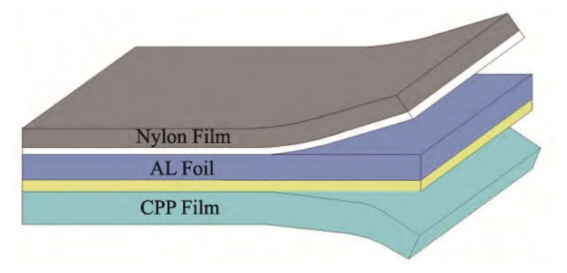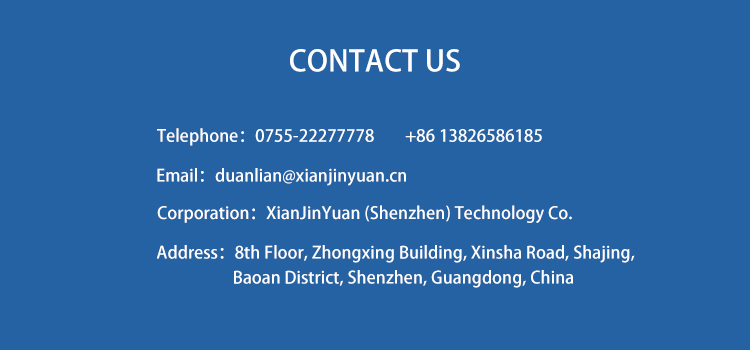

Hotline:0755-22277778
Tel:0755-22277778
Mobile:13826586185(Mr.Duan)
Fax:0755-22277776
E-mail:duanlian@xianjinyuan.cn
Aluminum plastic film flexible packagingIt can be divided into three layers, and the layers are bonded together by adhesive.

Aluminum plastic film structure
Inner layer - multifunctional layer (thickness 40 μ m~80 μ m)
The inner layer is designed for the electrolyte in lithium-ion batteries and has good chemical stability. As stable composite layers and heat sealing layers, film materials such as polypropylene, polyethylene, ethylene acrylic acid copolymers, polypropylene, or ion crosslinked polymer resins are commonly used to improve the electrolyte resistance of packaging materials, ensure the performance of the final battery, and prolong its service life.
Intermediate layer - barrier layer (thickness 35 μ m~40 μ m)
The middle layer aluminum foil serves as a barrier layer, mainly used to prevent moisture from entering the battery and electrolyte from seeping out from the inside. It needs to have good barrier properties, cold stamping forming properties, and double-sided composite properties.
Outer layer - protective layer (thickness 15 μ m~25 μ m)
The reason why the outer layer is called a protective layer is because the outer material used has good heat resistance (temperature of 160 ℃± 15 ℃), wear resistance, puncture resistance, and bending resistance, thus providing good protection for the barrier layer. In addition, there are certain requirements for cold stamping formability and printability. Considering the cost of outer layer materials, we usually choose polyester and nylon non-ferrous metal processing film materials.
In production, the main processes used for aluminum-plastic film are dry and hot methods. The dry process involves bonding aluminum and polypropylene with adhesive, and then synthesizing them in a dry pressed state; The thermal process involves bonding aluminum and polypropylene using porous polypropylene foam material, and synthesizing them through slow heating, pressure boosting, and hot pressing.

Dry process route
The main advantages of dry process aluminum-plastic film are good deep drawing forming performance, excellent short-circuit resistance, few surface defects, fast manufacturing speed, simple process, and low cost. But its peeling force is small, and its resistance to electrolyte and water requires the addition of special adhesives to ensure its performance.

Thermal process route
The aluminum-plastic film produced by thermal process has a strong bonding force between the aluminum layer and the polypropylene layer, which improves the ability to prevent electrolyte swelling and inner surface layer detachment. However, this specially treated adhesive needs to be melted at a higher temperature to achieve its bonding effect. Due to the differences in shrinkage coefficients of various materials, inward curling is prone to occur during the cooling process, resulting in poor appearance and cutting performance. In addition, heating causes the material to become brittle, resulting in poor deep drawing performance, poor short-circuit resistance, and relatively complex preparation processes.
In summary, the dry composite process is more common and widely used in the preparation of aluminum-plastic films, such as in high-energy and heavy-duty batteries for mobile phones, and high rate and high-capacity power batteries for electric vehicles; Thermal composite is generally only applied in fields such as 3C that do not require high battery capacity.
The technical barrier for aluminum-plastic composite film used in lithium batteries is very high, and domestic enterprises are focusing on nylon and other materials in the upstream of aluminum-plastic film CPP、 The raw materials such as rolled aluminum foil and adhesives are already "choked" by insufficient self-sufficiency. Even though high-end nylon technology has been breakthrough in recent years, CPP and aluminum foil, which have higher costs, still rely on imports. This is the key reason why the domestic market has been occupied by foreign companies for a long time. At present, domestically produced aluminum-plastic film is mainly used in the mid to low end 3C consumer electronics field, high-end 3C consumer electronics aluminum-plastic film and power soft packagingAluminum plastic film for batteriesThe raw materials used are still provided by foreign companies, and high-end products rely heavily on imports. Japanese and Korean companies such as Daihatsu Printing, Showa Denko, and Kuriki Chemical hold over 70% of the global market share and have formed a production and technology monopoly worldwide.
The development of new energy vehicles will become an important driving force for the prosperity of the aluminum-plastic film industry, and there is huge space for domestic substitution of aluminum-plastic film. One of the reasons is that the existing aluminum-plastic film production capacity of Japanese and Korean enterprises is limited, and the expansion speed is slow, and the release of production capacity cannot keep up with the rapid development of the global soft packaging industry; At the same time, the cooperation between Japanese and Korean companies and domestic customers is low, while domestic manufacturers have a higher degree of cooperation, which gives them an advantage in supply chain security.

Advanced Institute (Shenzhen) Technology Co., Ltd, © two thousand and twenty-onewww.avanzado.cn. All rights reservedGuangdong ICP No. 2021051947-1 © two thousand and twenty-onewww.xianjinyuan.cn. All rights reservedGuangdong ICP No. 2021051947-2